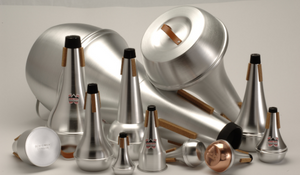3 Levels of Practice for Foodies


Hi, my name is Kate Amrine and I am a professional trumpet player and educator. I also love to cook and eat new foods. One of my favorite aspects of traveling to a new place is exploring the food scene. I discovered a cooking series on YouTube where a food scientist has three chefs of different levels (amateur, home cook, and expert) make the same dish yet in their own ways given their skillset and then it is evaluated afterwards. While all grilled cheeses have melted cheese and bread, one chef may use homemade sourdough or American cheese or have a fancier way of toasting the bread etc. Each chef in the show approaches the dish with their own skill level and makes the required food using all of their own talents and experiences. The food scientist then evaluates all of them as to how they fulfilled the task and whether their dish met the appropriate characteristics. As music educators we are constantly evaluating our students under dozens of criteria including pitch accuracy, rhythm, sound production etc. I currently teach students across all ages and levels and have found that regardless of background or experience on the instrument, these three levels of practicing (just as there were three levels of Chef) are applicable for everyone.

Level 1 The Basics
Level 1 to me is what most musicians start with on a new piece of music, regardless of their years of experience or capabilities on the instrument. Our first step when approaching a new piece of music is to establish accuracy and understanding of its basic components - in this case - the notes and the rhythms. This is still the same first step of understanding regardless if you have played a piece of music for the very first time or have never played it but listened to it many times. It happens both at a physical level (Have you ever heard the phrase “I just have to get it under my fingers” ? ) and also at a mental level (Ex. This piece is in F# and I need to remember my E is always sharp in this key). Without musical training, you can still be at this level on a piece of music. We all know how to sing happy birthday - at one point we were taught how the tune goes (i.e. Its notes and rhythms). You could be in Level 1 still learning the basics on the Grace Williams Trumpet Concerto but Level 3 (a True Performer) on the Haydn Trumpet Concerto. You can also be at Level 1 as a complete beginner and never progress beyond this level - and that’s ok. Perhaps you are a trumpet player deciding to play through a couple notes of Aliyah Danielle’s Contemplations on your friend’s french horn just to see how it feels. If you are still figuring out the notes and rhythms to a piece of music, you are in this stage. Surpassing Level 1 results in an accurate performance but is missing the extra musical elements to make it truly inspiring. If you feel like you have a good handle on the notes and rhythmic aspects of the piece and are ready to increase your musical understanding, then let’s proceed to level 2.

Level 2 - Extra-musical
Level 2 is what we see most students bringing to their private lessons, similarly regardless of ability. Maybe this is a fleshed-out etude that has been in the practice room a handful of times or a solo where some musical decisions are starting to be made but could be more convincing. This level is about making musical choices to increase the music making beyond just the notes and rhythms. This involves extra musical things like dynamics, changes to tempo, articulation, etc. Some of these can be things that are actually written in the music but can also be things that are added in each musician’s interpretation. You can be at Level 2 with one piece, like starting to figure out your own musical statements in Jennifer Higdon’s Trombone Songs but still be in Level 1 with Elizabeth Raum’s Fantasy for Trombone. One difference between Level 1 and Level 2 is that the recreation of what is on the page is done in a way that mimics recordings or playback, as opposed to creating your own interpretation. We want to sound as accurate as we can when playing but if you aren’t truly saying something musically then why would someone want to listen to you perform? Since we are fortunately humans, not robots or a song created by AI, we have the power and the responsibility to go beyond what is on the page. If you are feeling confident with your musical choices, then you are ready to move on to Level 3.
Get our newest tips, updates, videos, clinics, community events, and more by joining Denis Wick Tips Blog

Level 3 The Performer
Level 3 is that feeling of a truly free performance where you aren't worried about missed notes or how a certain section will go. It is not about playing a piece perfectly or with as much musicality as possible but rather when you are in a flow state and churning out musical opinions and contributions without asking questions with your interpretation. You feel effortless like you are simply performing what comes from your true musical self, rather than reading what the sheet music is telling you. We hear this in masterclasses and lessons, especially when the difference between performers is extremely clear. One person asks questions with their playing; maybe they are nervous or weren’t sure if a certain section was 100% how they wanted to interpret it. The other performer is truly performing the piece and making a strong statement. They are saying this is how it goes; this is my interpretation and I am sharing that with you right now. The difference between the two performers isn’t necessarily accuracy but asking questions and being unsure about their interpretation. As with the other levels, you can be in Level 3 on the new tuba solo by Velvet Brown titled “Love Letter’s but nowhere even close to it on the new piece you just commissioned and received last week.
One common issue I often face with my students is identifying the difference between Level 2 and Level 3. This is the trickiest because this is the level most students are at when bringing pieces into lessons. I have found that many students may be stuck in Level 2 for a while and unable to push through to be as musical as they can to be in Level 3. As a brass player, some specific things that take one from Level 2 and into Level 3 include things like breath marks. If you are truly as familiar as you possibly can be with a piece you are working on, you will have breath marks written in or at least know the spots you are trying to be mindful of. These can be moments when you really need to tank up the most amount of air as possible, or perhaps a place where you find you always need to sneak an extra breath. Whether or not you are truly following the dynamics, phrasing, and articulation that is written is another way of estimating whether you have fully progressed to Level 3. And we also can’t forget the tempo; is it robotic? Does it sound “musical”? Does it feel like the performer is just reading what is written and spewing it out to you or do you feel emotionally moved? The biggest difference between Level 2 and Level 3 is that a Level 2 performance has the performer saying “I think this is how it goes?” rather than a Level 3 performance of “This is how it goes and that’s all. No questions asked.” Lastly, a Level 3 performance of a piece doesn’t mean that this is the only correct version of this piece. As we know, there are a million recordings of insert brass concerto name here and many of them are definitely great and different Level 3 interpretations.
Describing these levels to students and showing them when they may be stuck in one level instead of seeing the bigger picture can be transformative to help students visualize and see outside the music what they can actually do to improve. The level of progress varies from piece to piece - but being able to characterize it, just like evaluating your own playing for the common qualifications we already endorse as musicians (accurate pitch, rhythm, musicality, etc) is game changing. Simply put: breaking down the point you are at with your practicing can be incredibly helpful in taking one’s playing to the next level.
Identifying these Levels and describing them is not intended to shame anyone or make anyone feel guilty in any way for being in different stages of development. We are all growing and improving as brass players every day we possibly can, and this is intended as another way of conceptualizing how to best learn new music. My intention with separating these concepts into levels is that we can push ourselves to grow from one level to the next, and more easily identify when we may be stuck in one level and need to expand our capabilities to the next. I hope that these descriptions and examples are helpful for your own practicing and teaching and please reach out if you have any questions.
**The musical examples I mention here were all pieces I heard performed at the International Women’s Brass Conference. If you are looking for some new brass repertoire, definitely check them out online. If you are interested in hearing about how I incorporate these concepts into my own practice - particularly in how to prepare for a solo recital with advance notice or a last-minute gig - then check out my post here.

Find all our Denis Wick resources in one spot on the Denis Wick app. Download to view videos, clinics, educator resources, podcasts, product information & more!




